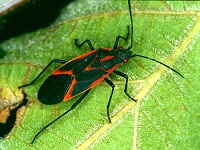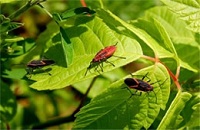Boisea trivittata
Host
Ash tree, Maple
Appearance and Life Cycle

Photo credit: Royalalbert-museum.ca

Photo credit: edupic.net/bugs.htm
A bug overwinters as an adult in dry, sheltered areas, such as buildings and house attics. In the spring, the bugs fly to their hosts and deposit eggs on developing leaves or in bark crevices. Within the two weeks the nymphs emerge and begin feeding on the underside of the leaves. The nymphs are black in color, except for a bright red abdomen which is eventually covered by blackwing pads that increase in size with development. As the leaves mature, the plant bugs prefer to feed on the succulent, developing seed pods. The adult plant bug is brownish black in color, with the wings outlined in red and the thorax marked with three red lines. The adults measure approximately 12 millimetres (mm) long and may be present as early as August. In the fall, the boxelder bugs may be found congregated in large masses on the sunny sides of trees, buildings and rocks. It is at this time the adults begin seeking hibernation sites and becoming an annoying household pest.
Damage
Both the nymphs and adults cause damage by sucking the sap from maple leaves and seed pods. The feeding action of the boxelder bug on the leaves causes speckling and distortion of leaf growth. The damage is more apparent on seed-bearing trees where higher plant bug populations are present. Generally the damage to the host is insignificant compared to the nuisance created by the pest congregating and searching for hibernation sites around dwellings in the fall.
Control
Control of the boxelder bug is desired mainly because the insect is a household nuisance rather than a pest of maple. The removal of leaves, rocks and boards around dwellings will discourage the congregation of this insect. Control of the boxelder bug may be achieved by applying insecticidal soap or by applying a product containing carbaryl or chlorpyrifos. These products are most effective if applied when the plant bugs are clustered together. These products are for outdoor use only. To prevent plant bugs from entering the household, repair cracks in foundations, windows and doors. The only means of controlling plant bugs within the dwelling is by collecting and disposing or vacuuming.